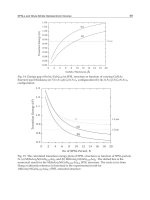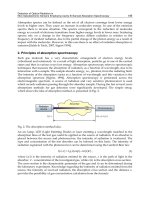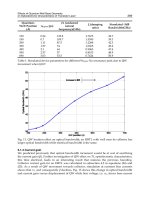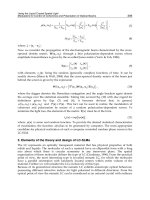PV SYSTEMS, COMPONENTS DEVICES AND APPLICATIONS
Bạn đang xem bản rút gọn của tài liệu. Xem và tải ngay bản đầy đủ của tài liệu tại đây (6.12 MB, 64 trang )
Prabir Kumar Dash
Scientist
Solar Energy Centre
Solar energy is the most abundant source of primary
energy ( 7.2 x 1018 kJ/day)
There are Two methods of harnessing solar energy
( photovoltaic & thermal)
Method Of Direct Conversion Of Sunlight To
Electricity Using Solid State Devices Is Called
Photovoltaic.
Generation Is Clean, Quite, and Reliable
Requires minimum operation & maintenance .
Some cases it is the cheapest option of meeting the
energy requirement.
A solid state device which produces current when
certain range radiation spectrum falls on it.
The operation consists of three steps.
1. Absorption of radiation ( pair production)
2. Charge separation
3. Collection ( flow of electron in the load circuit)
Various technology devices available are Crystalline
Si, a – Si, thin film technologies like CdTe, CIGS,
GaAs, DSSC and organic cells.
THEORITICAL EFFICIENCY ~BAND
GAP ENERGY OF MATERIAL
1st generation
Silicon wafer
2nd generation
Thin film on glass
3rd generation
Thin film on
flexible foil
4th generation
Organic cells.
Absorber thickness
≤ 200µm
Absorber thickness
≤ 3µm
Absorber thickness
≤ 3µm
Absorber thickness
≤ 3µm
Limited by wafer
size
Large area
deposition
Large area
deposition
Large area printing
Rigid
Rigid
flexible
flexible
Mature
Mature
Emerging
R & D stage
Limited cost
reduction potential
Limited cost
reduction potential
Low cost potential
lowest cost
potential
Solar cell is the basic building block
of any Solar PV system.
The current ~voltage characteristics are measured at Standard Test
condition (STC) defined by three parameters
1. Temperature ( 25 0 C), 2. Irradiance (1000 W/M2 ), 3. Spectrum (1.5G
AM)
Open circuit voltage
Short circuit current
Maximum/peak power
Voltage at maximum power point
Current at maximum power point
Fill factor
Series resistance
Shunt resistance
Inverse of slop at Voc is called series resistance Rs
Inverse of slop at Isc is called shunt resistance Rsh
It is the ratio between power output to power
input.
Out put power is the power at maximum power
point.
The input power can be calculated by
multiplying Irradiance with area of the PV
device.
For commercially available Crystalline Si cells
the efficiency is around 14-19%
For thin film modules it is 6-10%
Positive temperature coefficient of current-α
Negative temperature coefficient of voltage-β
Negative temperature coefficient of power-γ.
• Current is directly proportional to Irradiance
•Voltage has a logarithmic dependence on irradiance.
Effect of spectrum depends on the material
characteristics.
The defining parameter is called spectral response:
Amount of current produced per incident power
in watt
No of cells connected in series/parallel to
produce workable current/voltage.
All cells must be checked for micro cracks or
any other defects.
Cells to be connected in series must be current
matched
Cells to be connected in parallel must be
voltage matched.
Grid contacts should be uniform and optimized
to have minimum contact resistance.
The lamination must not have any air bubble or
pores for moisture ingression.
A bypass diode is connected parallel to the cell
string to prevent reverse biasing of the module
at partial/complete shading of the PV module.
A blocking diode is connected in series to the
PV module so as to prevent back flow of
current in from battery bank to Module at
night.
Rating of the diodes is such that it can carry a
current of short circuit current at a temperature
of 80 0 C for 5 hours.
Solarcell
Solarcell
Area
Area
Voltage:
Voltage:
100
100cm²
cm²
0,5
0,5Volt
Volt
Current
Current
Power
Power
3,0
3,0Ampere
Ampere
1,5
Watt
1,5 Watt
Typical values for standard
conditions:
•radiation
G = 1000 W/m²
•Cell temperature T= 25°C
•Air Mass
AM = 1.5 G
Solarmodule
Solarmodule
Solar
Solargenerator
generator
36
36Solar
Solarcells
cells
Voltage
18
Voltage
18Volt
Volt(36
(36* *0,5
0,5V)V)
18
18Solarmodule
Solarmodule
voltage:
108
voltage:
108Volt
Volt(6(6* *18
18V)V)
current:
current:
Power:
Power:
current
current
power:
power:
33Ampere
Ampere
54 Watt (36 * 1,5 W)
54 Watt (36 * 1,5 W)
99Ampere
Ampere(3(3* *33A)A)
972 Watt (18 * 54 W)
972 Watt (18 * 54 W)
Integrated assembly of PV modules and components
to produce power for a particular service.
May be for electricity generation, pumping water or
feeding power to lighting or any mechanical work.
Because of the modular characteristics, PV systems
can be designed to meet the energy demand from few
watt to megawatt.
Most favored for remote application where grid
extension is not possible.
Can be designed for both AC and DC load.
Can be classified according to their component
configurations, and how the equipment is
connected to other power sources.
Stand alone systems
Grid interactive systems
Hybrid systems
GRID CONNECTED SYSTEMS
STAND ALONE PV SYSTEMS
PV ARRAY
PANEL MOUNTING
STRUCTURE
COMBINER BOX
CHARGE CONTROLLER
BATTERY BANK
INVERTER
AC AND DC DISCONNECTS
MISCELLANEOUS
COMPONENTS(Cables,
connectors, conduit and
brackets)
LOADS









